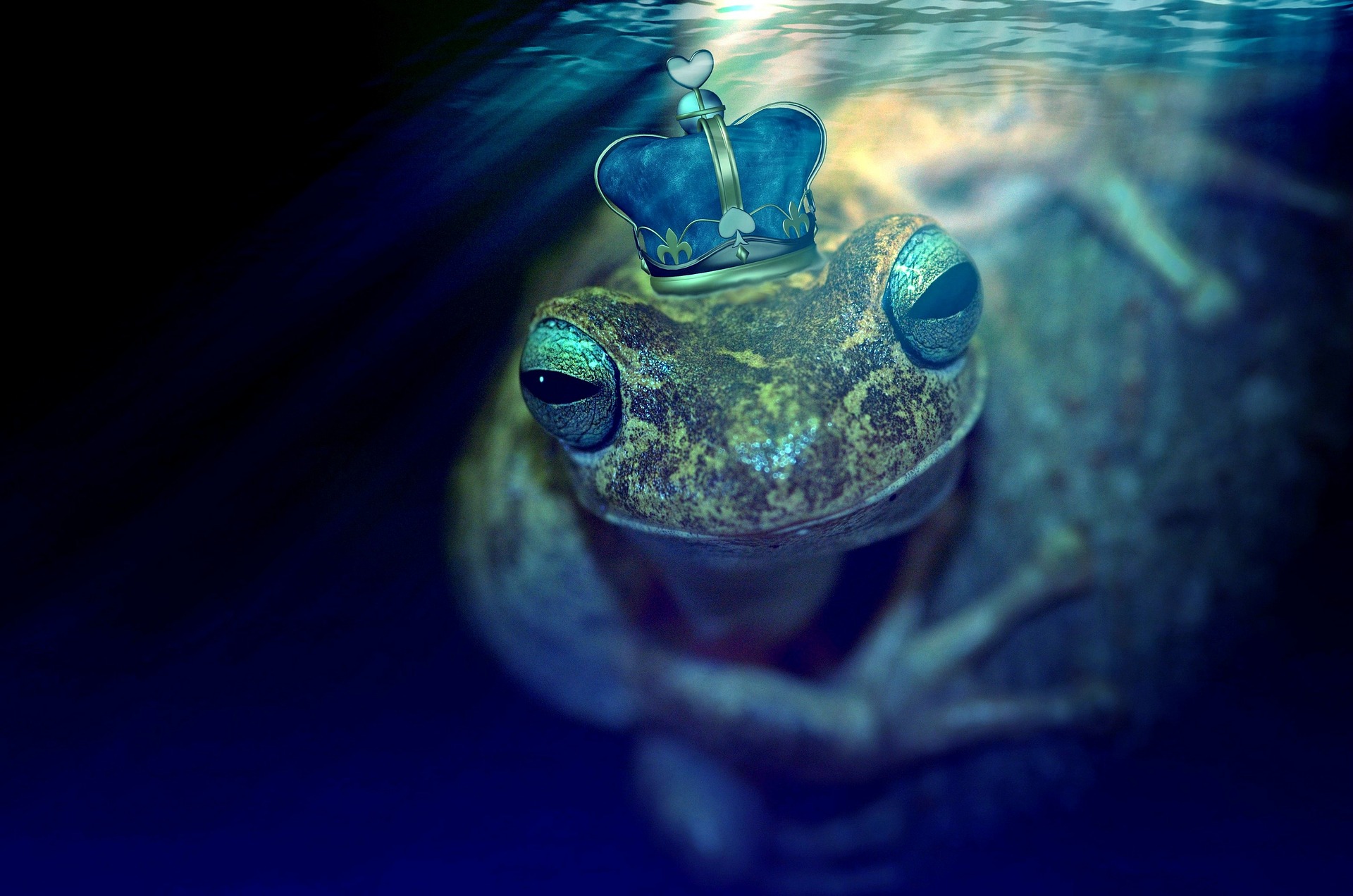Painful stories happen to all of us. A marriage or relationship goes sour. A job…

Stop kissing toads
We all know fairytales aren’t real. Or do we? Some of us still seem to confuse a toad with a prince (or princess.) We seem to believe that with enough love (and second chances), our bumpy relationship will magically transform into our dream come true. Yet, real relationships—romantic and otherwise—begin when we stop kissing toads and start using the magic wand of boundaries.
Our castle mote
Boundaries are limits we set around behavior we expect, and behavior we won’t accept — from ourselves or from others. Strong boundaries are like a mote around a castle, with a drawbridge that we control.
When we’re weak or fuzzy on our boundaries, it’s like keeping the drawbridge available 24/7. So, any old vagabond can enter our castle, enjoy the gifts we offer, make a big old mess, and leave it behind for us to clean up. (Never done that before!)
On the other hand, if we keep the drawbridge locked up 24/7, no one can penetrate our castle walls. Neither makes for a fairytale ending.
A reciprocal agreement
Many of us weren’t raised around healthy boundaries. In fact, they weren’t even part of the mainstream conversation until the mid-80s. It’s no wonder so many adults struggle with establishing—and respecting—boundaries.
Unfortunately, lack of boundaries is often a root cause of issues within families, friendships, romantic relationships, and even the workplace.
In healthy relationships, boundaries are clear and a two-way street: People know and respect our boundaries, and we know and respect theirs.
That’s the only way we can truly feel safe showing up with an open, honest heart. Whether that’s gaining the courage to reveal our deepest fears and desires to another person or to share a perspective that goes against popular opinion, at home or at work.
The road to regrets
Some of us may confuse ‘forgive and forget’ with ‘enable and regret.’ Meaning, someone can betray or hurt us a million times and we’ll still grant another chance. We’re not foolish — it’s just that we’ve likely been conditioned to believe that this is the kind, generous, even Christian thing to do.
It’s not.
In fact, in the bestselling book, Boundaries, Drs. Henry Cloud and John Townsend outline a biblical-based perspective on setting limits in all areas of our lives. While I’m not a religious person, I highly recommend this book. To me, learning to create boundaries is about honoring our inner spirit. But we need to know how and this book offers some great insights.
Desires not demands
Another thing about boundaries is that they are completely subjective: What some of us think is okay behavior, others would not. Sometimes we just assume another person understands this about us, which naturally causes problems.
It’s our responsibility to clearly define this for ourselves. If you’re not so clear, spend some time reflecting in a journal on relationships that work and those that don’t – and why. Then make a list of what you expect in order to feel safe, loved, and respected. (For example: In my relationship with person A, I expect X, Y, Z.)
This may feel selfish or judgmental at first, but it’s not! It’s important to clarify what works and what doesn’t — for YOU. We all have the right, and the responsibility, to determine our needs and desires.
Once we clarify this for ourselves, we also need to decide what the consequences will be if they’re violated. And stick to them! This can be tough, especially if we’ve indulged certain behaviors in the past. But if we continuously waffle, our drawbridge is essentially useless.
Remember, this is not a list of demands we hand over like a ransom note. Anyone may choose to discard our needs, but we always reserve the right to choose how we respond.
Going for all the marbles
As Stephen Covey wrote in The 7 Habits of Highly Effective People, love is verb not a noun. People demonstrate love (and trust and respect) through their actions. While no one is perfect, paying attention to patterns of behavior can help determine who is ‘perfect’ for us.
I like the simple yet powerful concept that writer and researcher Brene Brown teaches: The marble jar.
Each time someone demonstrates a positive, trust-building behavior, we put a marble in the jar—literally or metaphorically. Each time they demonstrate opposite types of behaviors, we remove one of the marbles.
For example:
- Was this person true to their word—did they call/ show up/ do what they promised? Marble!
- Did they truly listen without judgement or criticism — and maintain confidences? Marble!
- Did you notice this person stretching the truth or outright telling lies? Subtract a marble!
- Did this person shame/ embarrass you—or hit below the belt in an argument? Subtract a marble!
Keep in mind, some actions may warrant multiple marbles.
Over time, this creates a strong visual for who demonstrates loving behaviors and who does not. And as they say, past behavior is the best predictor of future behavior.
Braving the way
Some of us may be confused about what loving behavior is supposed to feel like, especially if we’ve been raised without it. Through her extensive research, Brene identified common behaviors that cultivate trust, intimacy, and authentic connection in relationships.
In other words, marble jar people.
This not only helps us determine who those are in our lives, but also how we can show up as marble jar people for those we love.
Brene uses the acronym BRAVING for these behaviors: Boundaries; Reliability; Accountability; Vault; Integrity; Non-Judgment; Generosity.
When we look at ourselves and others through the lens of these behaviors, it becomes clear who constitutes a marble jar person and who does not.
Remember, the Prince (or Princess) Charming who knows just how to sweep us off our feet is a fairytale. Worse yet, it may be the façade of a narcissist who knows just what to say to make us swoon. (Watch Netflix much?)
Take the slow lane
We live in a fast-paced world, but it’s important to remember that trust and intimacy take the slow lane. It can be easy to get sucked in by a Prince or Princess Charming who is all flash, no substance.
Brene’s slow and steady approach means we stop kissing toads—and stop attracting slimy swamp creatures in the first place! (Tip: Swamp creatures hate healthy boundaries.)
Before we let our drawbridge down, we need to take the time to verify credentials (AKA behaviors). Most of us know that once we’re ‘shacking up’ in the same castle, it can be challenging—and costly—to reverse course. Both financially and emotionally.
When it comes to friends or colleagues, it can be equally devastating to discover that we’ve trusted someone who violates the ‘BRAVING’ behaviors.
Address any battle scars
It takes courage, vulnerability, and integrity to be honest, real, and authentic in a world where so many are not.
It’s even more challenging if we carry the battle scars of betrayal, rejection, caustic criticism, judgement, shame, and other emotional wounds. To overcome these challenges, we need to identify the wounds and heal them.
Then, as we learn that we have the right (and responsibility) to set boundaries and stop kissing toads, we foster healthier self-esteem — and higher vibrational energy. Using the marble jar approach can help us feel safe while beginning to slowly trust others, and ourselves, again.
Eventually, toads don’t even hold appeal anymore. Plus, when they sense strong boundaries, they usually hop away and find someone else to bother.
Stop kissing toads
Of course, sometimes ‘stop kissing toads’ means we need to let go of someone we thought we really liked or even loved — or at least, limit our exposure. But as Brene says, only marble jar people deserve to be part of our inner circle.
Plus, toads don’t deserve to enjoy the precious jewels that we are.
Yes, jewels, my friends.
Each of us is a precious jewel that sparkles with unique and special qualities: Our laughter, our kindness, our empathy, our grace, our sensitivity, our love. And so many more magnificent qualities. If we do NOT feel this way, it’s time to understand why. (For ideas, check out my blog Say goodbye to the yellow brick road.)
When we love, honor, and respect ourselves as precious jewels, we begin to attract people who love, honor, and respect us, too.
I’m so grateful for my marble jar friends who each bless my life with their one-of-a-kind sparkle. Not to mention, the toads whose behavior inspired me to learn how to build a bigger mote.
Get more Good Vibrations!
I’m a holistic life coach who specializes in expressive writing to nurture healing, insight, and creativity. For more information about life coaching, visit my website at www.manifestwithmargrita.com or email me at CoachMargrita@gmail.com. And share my Good Vibrations blog with others!



